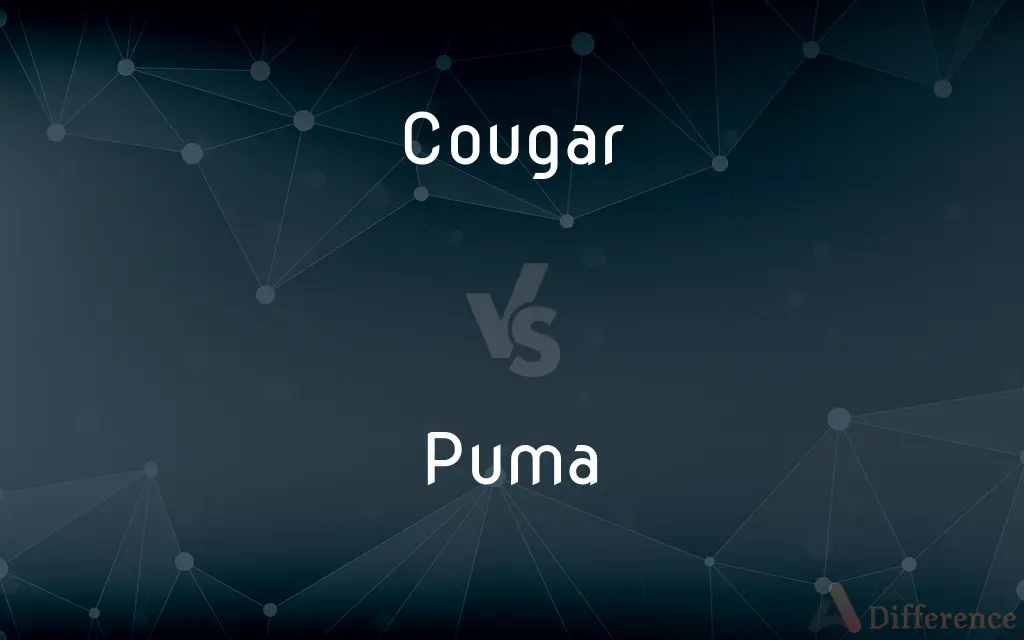Cougar vs. Puma — What's the Difference?
Edited by Tayyaba Rehman — By Fiza Rafique — Updated on November 2, 2023
Cougar and puma are two names for the same animal, a large feline of the family Felidae native to the Americas.

Difference Between Cougar and Puma
Table of Contents
ADVERTISEMENT
Key Differences
A cougar is a large cat known scientifically as Puma concolor. The name "cougar" is commonly used in North America and particularly in the United States. When one refers to a cougar, they are talking about a powerful predator that has a wide range that extends from the Canadian Yukon to the Southern Andes of South America.
The term "puma" is also used to describe the same animal and is more commonly used in Latin America and parts of Europe. "Puma" can be considered a more universal term for this cat species. It is of the same genus and species as the cougar, sharing the same biological characteristics and behaviors.
Both cougars and pumas hold significant roles in their natural habitats, serving as top predators. They are solitary and elusive creatures, which contributes to the different names they have been given based on regional dialects and histories. This variety in nomenclature is reflected in other names such as "mountain lion" and "panther."
The names "cougar" and "puma" do not reflect any difference in physical characteristics or behaviors of the animal; they are merely different common names used in different regions. For example, in North America, one might say, "The cougar roams the mountainous regions of the Pacific Northwest," while in South America, it could be, "The puma is an apex predator in the Patagonian landscape."
It's worth noting that both terms have extended beyond their zoological use. "Cougar" has developed an informal usage in English-speaking cultures to refer to an older woman who seeks romantic relationships with much younger men. There is no such cultural connotation associated with the word "puma."
ADVERTISEMENT
Comparison Chart
Common Usage
Predominantly in North America.
Used internationally, especially in Latin America and parts of Europe.
Scientific Name
Puma concolor
Puma concolor
Etymology
From the Portuguese “cuguacuarana”.
From the Quechua language.
Cultural Connotation
Slang for older women dating younger men.
No widespread cultural connotation.
Synonyms
Mountain lion, panther.
Mountain lion, panther.
Compare with Definitions
Cougar
A solitary predator.
A cougar typically hunts at dawn or dusk for deer and other animals.
Puma
A large American wild cat.
The puma is known for its agility and powerful limbs.
Cougar
A term in popular culture.
In popular culture, a cougar refers to an older woman seeking a relationship with a younger man.
Puma
An emblem of wilderness.
The puma often symbolizes untamed wilderness in South America.
Cougar
A large North American wild cat.
The cougar is adept at climbing, which helps it hunt and evade threats.
Puma
A keystone predator.
As a top predator, the puma plays a crucial role in maintaining the balance of its ecosystem.
Cougar
An animal with a wide range.
Cougars have the widest range f any wild terrestrial mammal in the Western Hemisphere.
Puma
A name derived from Quechua.
The word puma comes from the South American Quechua language.
Cougar
A name with Portuguese origins.
The word cougar was adopted from the Portuguese language.
Puma
A creature of many names.
The puma is also called a mountain lion, among other names.
Cougar
The cougar (Puma concolor) is a large cat of the subfamily Felinae. Native to the Americas, its range spans from the Canadian Yukon to the southern Andes in South America and is the most widespread of any large wild terrestrial mammal in the Western Hemisphere.
Puma
A German multinational corporation that designs and manufactures athletic and casual footwear, apparel and accessories
Cougar
A large powerful wild cat (Puma concolor syn. Felis concolor) chiefly of mountainous regions of the Americas, having an unmarked tawny body and a long tail. Also called catamount, mountain cat, mountain lion, panther, puma; Also called regionally painter.
Puma
A large American wild cat with a plain tawny to greyish coat, found from Canada to Patagonia.
Cougar
(Slang) A woman, especially one over 30, who romantically pursues or attracts younger men.
Puma
See cougar.
Cougar
Puma concolor, a wild feline native to the Americas.
Florida panther
Puma
A mountain lion or cougar (Puma concolor).
Cougar
An older woman who actively seeks the casual, often sexual, companionship of younger men, by implication a female “sexual predator”.
A cougar approached Warren at the Palomino Club and asked for a dance.
Puma
(by extension) Any feline belonging to the genus Puma.
Cougar
An American feline quadruped (Felis concolor), resembling the African panther in size and habits. Its color is tawny, without spots; hence writers often called it the American lion. Called also puma, panther, mountain lion, and catamount. See Puma.
Puma
(slang) A woman in her 20s or 30s who seeks relationships with younger men; a younger cougar.
Cougar
Large American feline resembling a lion
Puma
A large American carnivore (Felis concolor), found from Canada to Patagonia, especially among the mountains. Its color is tawny, or brownish yellow, without spots or stripes. Called also catamount, cougar, American lion, mountain lion, and panther or painter.
Puma
Large American feline resembling a lion
Common Curiosities
Is there a biological difference between a cougar and a puma?
No, they are the same species, Puma concolor.
Can "cougar" refer to something other than the animal?
Yes, it can also refer to an older woman seeking a relationship with a younger man.
Which term is more commonly used in the United States?
"Cougar" is more commonly used in the United States.
Where did the term "puma" originate?
The term "puma" originates from the Quechua language spoken in South America.
Is "puma" used in Europe?
Yes, "puma" is the term often used in Europe to refer to this species.
What do cougars typically eat?
Cougars are carnivores, typically hunting deer, elk, and smaller mammals.
Are there other names for this animal besides cougar and puma?
Yes, including mountain lion, panther, and catamount.
Are cougars good climbers?
Yes, cougars are excellent climbers, which helps them hunt and protect themselves.
Do cougars or pumas pose a threat to humans?
They usually avoid humans, but there have been rare instances of attacks.
Do cougars and pumas have the same habitat preferences?
Yes, both names refer to animals that can live in a variety of habitats from forests to mountains.
Are pumas endangered?
Puma populations vary; some are stable, while others are threatened or endangered.
Are cougars social animals?
No, cougars are solitary except during mating or when mothers are raising cubs.
How large can a puma get?
Pumas can weigh up to 220 pounds and measure up to 8 feet long from nose to tail tip.
Why are there different names for the same animal?
Different names arose due to regional language differences and the wide range of the species.
How many names are there for Puma concolor?
There are over 40 English names for Puma concolor.
Share Your Discovery

Previous Comparison
Seraph vs. Cherub
Next Comparison
Forest vs. RainforestAuthor Spotlight
Written by
Fiza RafiqueFiza Rafique is a skilled content writer at AskDifference.com, where she meticulously refines and enhances written pieces. Drawing from her vast editorial expertise, Fiza ensures clarity, accuracy, and precision in every article. Passionate about language, she continually seeks to elevate the quality of content for readers worldwide.
Edited by
Tayyaba RehmanTayyaba Rehman is a distinguished writer, currently serving as a primary contributor to askdifference.com. As a researcher in semantics and etymology, Tayyaba's passion for the complexity of languages and their distinctions has found a perfect home on the platform. Tayyaba delves into the intricacies of language, distinguishing between commonly confused words and phrases, thereby providing clarity for readers worldwide.














































